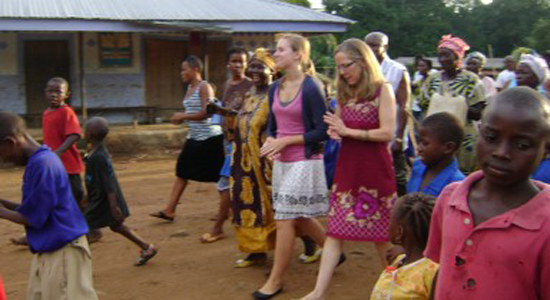After a very complicatedly pulled-off bucket shower (with no electric lighting) and a breakfast of fried eggs, bananas, papaya, and Nescafe — my mother, myself, and the CD Peace team piled into an SUV and onto several motorcycles and headed out to the rural community of Mapaki. As we arrived, we were once again greeted by the community. This time probably 300 school children in uniform were lining the pathway into the center of town, as they were singing welcome and reaching out to touch our hands. At the end of the path, we were greeted by Paramount Chief Kabombor II and women of the community, who several with babies on their backs, as the women were dancing and singing. Once the entire team made it through the crowd we were ushered into the community hall with the Chief and the women as the children all ran back to class.
Opening with two traditional prayers, one Christian and one Muslim, the Paramount Chief warmly welcomed the CD Peace representatives and the “big strangers” (my mother and I) to the Paki Masabong Chiefdom. For our benefit, he also delivered a short history of the chiefdom, The history portrayed one of the smallest in Sierra Leone (only 76.5 square km and 19,750 people); which, although devastated by the war, and being one of the poorest chiefdoms, is now regarded as one of the most peaceful chiefdoms in the country. We spent the next six hours preceding the meeting with a tour of Masaki and witnessing the work that CD Peace has done there. We saw the library (complete with computers and internet access), the primary and secondary schools, the community’s oxen, the community center, and the health center.
Everywhere we went, little children would run up to me, grabbing my hands, and walk around me in a crowd. Though, the children appeared to be disappointed in my lack of ability to speak Temne, one of the two native tongues of the chiefdom. One little boy, in particular, named Sagbe, adopted me and walked with me around the crowd. He waited for me outside the centers we visited, and again taking my hand when we came back outside.
I found all the sites we visited to be particularly impressive, but the secondary school interested me the most personally. There, we were greeted by the entire (and extremely attentive and respectful) student body. We had the opportunity to walk through the classrooms (one grade level each, some holding over one hundred students), and actually were able to meet with the principal and faculty of the school to discuss the institution and the challenges it faces. Among the teachers was a young Peace Corps volunteer named Andre who is teaching English grammar at the school and happened to be from the same area of Massachusetts as my mother.
During our meeting, the Principal informed us how the school was lacking in equipment (dictionaries, sports jerseys and soccer balls, and laboratory equipment) and money to provide the students with financial need (most of them) with scholarships. (CD Peace had explained to us earlier how these scholarships are determined, by financial need obviously, but also by academic merit and “politeness.”) The school also doesn’t have enough funding to pay their teachers, with four of them working on a purely volunteer status currently.
Like many schools in the area, one of their current focuses is to specifically target female students, and by the size of their female student body, they seem to be somewhat successful. However, in the highest class (about the equivalent to the 8th grade in the US, and which requires an entrance examination) only three students out of a class of roughly 20 were females. Examinations are required to advance into this level, as well as into Senior Secondary School (high school) and to be admitted into university. The principal also proudly let us know that, in these examinations, the rural student population (including his students) traditionally outperform their urban counterparts, who often have to travel less of a distance to go to school. Some of the pupils have to walk four miles to school each way every day, and there are rather severe tardy policies.
Fortunately, the secondary school recently received money for a new building, which is currently under construction, and we were able to take a quick tour. It was beautiful and much more spacious (with more than one room per grade level) and, as Andre appreciatively pointed out, “the chalk boards actually have chalk ledges!” Like many of the newly constructed schools we have seen along the highways, it is painted in the colors of the Sierra Leonean flag: green, white, and blue.
On our way back to Mayagba in the car, I would wave to the little kids standing by the road who would run after us screaming delightedly “Utopo! Utopo!” (White person! White person!) It is an interesting experience to be such a novelty and garner so much attention to yourself just simply by being there.
When we returned to Mayagba we were able to visit the building site for the new headquarters of CD Peace, including a new center for the children, where they will have areas for homework, music, and art. We then returned back to the current headquarters where Sallay, CD Peace’s amazing cook, had dinner ready. She said her mission was to “fatten me up before I returned to America,” which, with the fondness I’ve developed for her fried bananas probably wouldn’t prove too difficult, and is a reason it is food we are leaving tomorrow morning… sadly, no rain tonight.
by: Kyra Ellis-Moore

